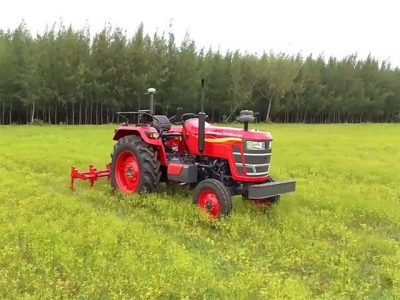Using radish to control cyst eelworm

A fodder radish crop can exterminate up to 95% of a cyst eelworm population and be used for biofumigation, writes Bill Kerr.
To control nematodes and pathogens with biofumigation, the radish crop must be finely chopped.
The past few issues have covered various ways to control cyst eelworm. But the most practical solution is the biological option. This entails planting a crop which the eelworm recognises as a host crop, causing the eggs in the cyst to hatch but not develop into females. The crop is fodder radish, which has been specially bred for this purpose. It’s like a Japanese radish, but instead of forming a large, fleshy root, it produces more leaf growth. When the radish roots approach a cyst, they deliver exudates which the eelworm eggs recognise as an invitation to hatch and feast.
The newly hatched L2 larvae enter the root (as described in a previous issue), but due to a peculiarity with this type of radish, are unable to develop the giant cells necessary for them to develop into females. They remain L2 larvae, or develop into males, and the breeding cycle is interrupted. With nearly all the cyst eelworm larvae induced to hatch but not able to reproduce, the population plummets without recourse to expensive, harmful chemicals.
Although radish varieties vary in their effectiveness, the eelworm population can drop by up to 95% when the biological option is used correctly. The percentage control is only slightly lower than with methyl bromide.
The crop is also a green manure crop, so the benefits go beyond eelworm control.
The right timing
The best time to plant this eelworm trap crop is towards the end of winter so that by the time the weather is warm and suitable for hatching, the root system will have covered the effective soil profile. The timing also makes economic sense. Vegetable crops planted at this time don’t usually get the best prices, as it’s usually a safe period with over-production likely. On the Highveld, eelworm hatching is usually compromised by temperature by May.
Alternative uses: biofumigation
Brassicas like fodder radish can also be used for biofumigation. There are 30 to 40 different glucosinolates in these crops which, when combined with the enzyme myrosinase, produce products such as isothiocynates which have a mild fumigation action. After chopping, the residue has to be incorporated immediately, as isothiocynates are so volatile, and the land needs to be rolled and irrigated to seal the chemicals in the soil. Biofumigation won’t help control cyst eelworm, but it supresses many nematodes. There are also claims that it can be used to reduce pathogens like Pythium, which causes cavity spot in carrots, but evidence is inconclusive.
California’s carrot packers commissioned biofumigation trials due to severe cavity spot, and the pressure to remove chemicals which help control it. But they found that cavity spot increased in the biofumigation plots. Conversely, in Australia they’ve had great success using biofumigation against bacterial wilt on tomatoes.
Có thể bạn quan tâm
Phần mềm

Phối trộn thức ăn chăn nuôi

Pha dung dịch thủy canh

Định mức cho tôm ăn

Phối trộn phân bón NPK

Xác định tỷ lệ tôm sống

Chuyển đổi đơn vị phân bón

Xác định công suất sục khí

Chuyển đổi đơn vị tôm

Tính diện tích nhà kính

Tính thể tích ao hồ



 10 Summer Squash Varieties: Some You Know, Some…
10 Summer Squash Varieties: Some You Know, Some…  Getting it right with sweet potatoes
Getting it right with sweet potatoes